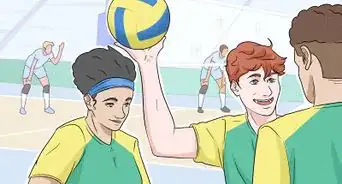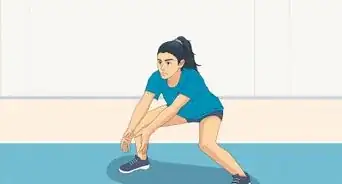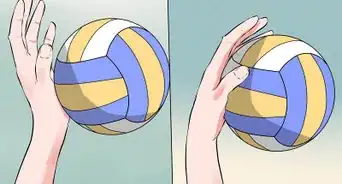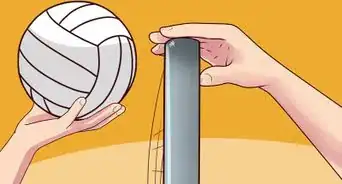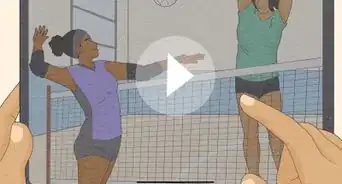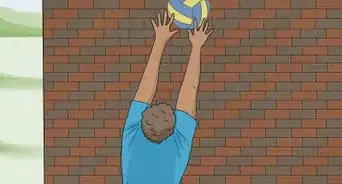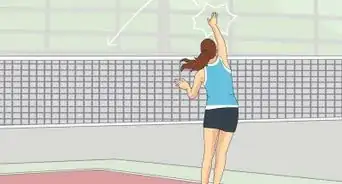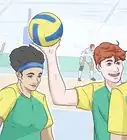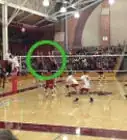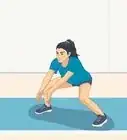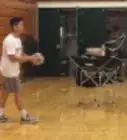wikiHow is a “wiki,” similar to Wikipedia, which means that many of our articles are co-written by multiple authors. To create this article, 83 people, some anonymous, worked to edit and improve it over time.
wikiHow marks an article as reader-approved once it receives enough positive feedback. This article received 12 testimonials and 86% of readers who voted found it helpful, earning it our reader-approved status.
This article has been viewed 703,870 times.
Learn more...
The bump, professionally known as a pass, is the most basic and essential skill in volleyball. The bump is used to hit a ball that is below the head, or at your platform as most volleyball players would call it, and is typically used as the first touch to receive a serve or to receive a hard-driven hit. In order to be successful in this sport, you must know the basics and bumping, officially known as passing, is the most important skill.
Steps
-
1Get into position. You should stand with your legs about shoulder-width apart and should lean forward a bit. Your knees should be bent a little bit, ready to spring your legs into action. Your hands should come together in the last moment before the ball comes to you; when you approach the ball, you can keep your hands about half a foot apart, and bring them together when the ball comes toward you. Otherwise, it'll be hard to maneuver yourself to get in the right position to hit the ball.[1]
-
2Create a platform with your arms. The platform is the area between both your wrists and elbows which is the "sweet spot" for hitting the ball. To create your platform, the most important thing you need to do is to clasp your hands together correctly while holding your arms straight in front of you, slightly below your waist, with your shoulders arched. Clasp your hands in front of you, with your thumbs together, side-by-side. Don't lace your fingers together, for this will make you lose control of the ball.[2]
- You can either make a fist with one hand and wrap the other around it (the ball method), or you can bend one thumb down to its palm, and rest it on the other hand (the cup method), thus cupping it with the other hand.
- If you're using the cup method, then your thumbs should be parallel with each other, and your four fingers on each hand will be parallel with each other as well.
- Remember to keep your elbows locked and your knees bent.
Advertisement -
3Use your legs. Using your knees, and your arms, push through the ball. If you're a younger player (12 and under), you can benefit from bending your knees and using them to power your legs and get momentum to guide the ball.
-
4Hit the ball with both arms. Position yourself so that you hit the ball with both. Otherwise, you won't be able to aim the ball correctly and could be fouled. This can be a bit tricky, when the ball is coming at you at an unexpected angle, but it's always important to position yourself so that your ball hits your arms with equal force so you can aim and hit it correctly.[3]
-
5Move to the ball so that it will come down squarely in front of you. You can bump the ball backwards, of course, but you still want to make sure that you make contact with the ball right in front of you (you may need to turn away from the net). You should face the direction the ball is coming with your shoulders and the front of your body for best results.[4]
- If you don't need the ball to go back, swing your arms or bring them above your shoulders. If you do need it to go back, carefully swing your arms backward, as much as is needed.
-
6Pass the ball. Keep your eye on the ball. Follow the trajectory of the ball as it comes down and even as you hit it. Make contact with the ball at about waist-level. When the ball is right above your forearms, straighten your legs so that your arms move up to meet it. Try to contact the ball on your forearms (above the hand but below the elbow joint.). At the same time, move your arms forward and up slightly, but do not swing your arms. Contrary to what a lot of people think, the majority of the force should come from your legs.[5]
-
7Aim the ball. Dip or twist your shoulder to aim the ball. You can't really aim with your forearms, because you need to keep them flat in order to provide a good platform for the ball. Instead move from the shoulders so that both arms stay together and move as one unit. Ideally, you can square up with the ball (point your feet at the target) so you can just hit it straight forward. Remember to aim the ball slightly to the right of the center of the net, since that is where the setter should be standing.[6]
- You should drop the shoulder and put the weight on the ball that is moving towards the target. Use your platform to help you aim the ball.
-
8Keep your eye on the ball after you bump it. Watch the ball with your eyes, not your whole body, try to keep your chin down, because it gives you more control of the ball. Some coaches will even have you put the collar of your shirt in your mouth to keep your chin down.
- Once you release the ball, separate your hands, but still keep them half a foot or so apart, anticipating the ball's next movement and get ready to hit the volleyball.
Community Q&A
-
QuestionHow do I bump with more force?
 Community AnswerThe lower you get, the more push you have when you stand up. The key is to not swing your arms.
Community AnswerThe lower you get, the more push you have when you stand up. The key is to not swing your arms. -
QuestionWill it affect me if my arms are lower than my waist?
 Community AnswerYes. The ball will fly down and under the net instead of nice and high. To fix this, bend your legs more so that you are closer to the ground.
Community AnswerYes. The ball will fly down and under the net instead of nice and high. To fix this, bend your legs more so that you are closer to the ground. -
QuestionHow do I control a volleyball?
 Community AnswerTo move it towards the right, drop your right shoulder a little. To move it to the left, drop your left shoulder. The closer your hands are to the ground, the lower the volleyball will go.
Community AnswerTo move it towards the right, drop your right shoulder a little. To move it to the left, drop your left shoulder. The closer your hands are to the ground, the lower the volleyball will go.
Warnings
- Do not cross your thumbs under any circumstances as it is possible to break a bone bumping that way.⧼thumbs_response⧽
- Don't lift or "carry" the ball. The bump should be a quick hit. If the ball stays in contact with your body for too long, you could be called for a fault and lose a point.⧼thumbs_response⧽
- If you have tender skin, or bony arms, it is likely that your forearms will hurt when you have hit the ball a few times. Don't worry, if you power through it, you will get used to it, and it will stop hurting.⧼thumbs_response⧽
- Do not hit the ball with your hands. Many people say it hurts to play volleyball but it is usually because they are hitting the ball with their hands. In addition, the hands do not make a good, flat platform, and you're bump will likely go errant.⧼thumbs_response⧽
- Be sure not to cross your fingers. This could lead to injury if the ball accidentally hits your hands.⧼thumbs_response⧽
References
- ↑ https://volleyball-basics.weebly.com/bump.html
- ↑ https://www.volleyball1on1.com/how-to-bump-a-volleyball/
- ↑ https://thephysicsofvolleyball.weebly.com/the-physics-of-bumping.html
- ↑ https://www.strength-and-power-for-volleyball.com/volleyball-pass.html
- ↑ https://www.stpaul.gov/sites/default/files/Media%20Root/Parks%20%26%20Recreation/Muni%20Volleyball%20fundamentals.pdf
- ↑ https://volleyball-basics.weebly.com/bump.html
About This Article
The easiest way to bump a volleyball is to stand with your feet shoulder-width apart and your knees bent. Lean forward and place one hand on top of the other, with your palms up and your thumbs touching. Stretch your arms out and lift them upward to bump the ball. For more tips on technique, passing, and aiming, read the article!
